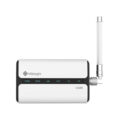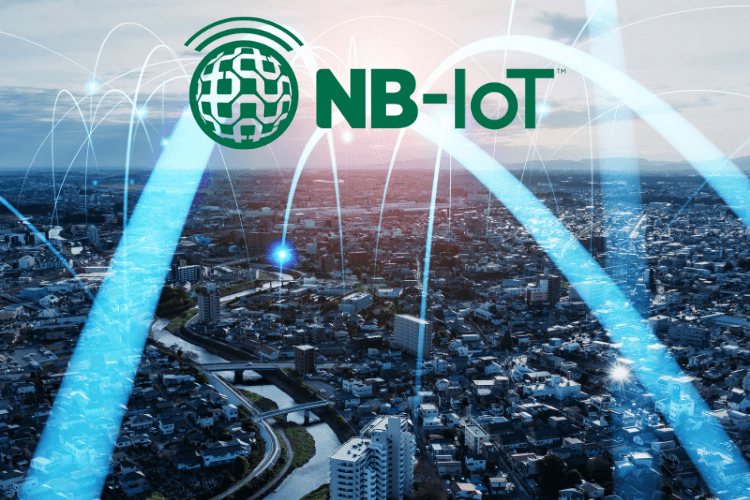LoRaWAN gateways: differences, selection and installation

The "radio base station
Generally speaking, a LoRaWAN gateway is used to establish wireless communication between LoRaWAN end devices, also known as nodes, and a LoRaWAN network server (LNS). It is, so to speak, the connecting component between the two and therefore an important sub-component of a LoRaWAN wireless network infrastructure. Without gateway(s), the sensor data cannot be transmitted to the LoRaWAN network server and other cloud applications.
How does the communication between end devices and gateway work?
The gateway receives radio signals from the LoRaWAN end devices (nodes) and forwards them to the LoRaWAN network server (uplink). At the same time, the gateway sends data from the network server back to the end devices (downlink). For communication with the end devices or LoRaWAN sensors, the gateway uses the LoRaWAN protocol. The connection from the gateway (radio base stations) to the network server (LNS) is in turn made either via Ethernet, WLAN or LTE (4G). In the process, a gateway is able to receive data from thousands of sensors.
LoRaWAN - secure through end-to-end encryption
Authentication and encryption are mandatory. Unlike many other IoT technologies, the LoRaWAN specification already offers application providers dedicated end-to-end encryption. The data is transmitted completely encrypted. AES encryption is used here in accordance with the security measures for wireless networks as per IEEE 802.15.4.
The specification defines two layers of cryptography:
- Use of a unique 128-bit network session key shared by the end device and network server (NwkSKey).
- Use of a unique 128-bit application session key (AppSKey) shared end-to-end at the application level.

Differences between indoor and outdoor gateways
Indoor and outdoor gateways differ in their intended use and thus in their properties.
Indoor gateways are designed for use in closed rooms. They are usually somewhat smaller and easier to install than outdoor gateways, comparable to WLAN access points. Typical areas of application are business premises, warehouses or production facilities. Indoor gateways offer a limited range, which is influenced by the building structure and the building materials used.
Outdoor gateways, on the other hand, are designed for outdoor use and area coverage. They are more robust, weatherproof and offer a greater range than indoor gateways. Outdoor gateways are often used in urban, industrial or agricultural environments to ensure comprehensive network coverage. Here, they are able to receive data from sensors over greater distances and even under difficult environmental conditions.
The choice of the right gateway type depends on the requirements of the respective area of application. Factors such as range, environmental conditions and installation options play a decisive role.
LoRaWAN Gateways in our m2m Shop
Milesight UG65 LoRaWAN Indoor Gateway
The UG65 from Milesight is a universal indoor gateway that can also be used in industrial environments. It supports the connection of more than 2000 LoRa nodes via Ethernet, WiFi or cellular (LTE/4G).
Milesight UG67 LoRaWAN Outdoor Gateway
Milesight's UG67 is an outdoor gateway with a range of up to 10 km. It supports the connection of more than 2000 LoRa nodes via Ethernet, WiFi or cellular (LTE/4G). Its waterproof housing (IP67) makes it suitable for versatile outdoor applications such as smart agriculture or smart metering.
Wattsense Bridge
The Wattsense IoT/LoRaWAN gateway combines PLC functionality with a gateway and connects both wired and wireless devices used in building automation. In addition to LoRaWAN, field communication protocols such as Modbus TCP/IP, Modbus RTU, BACnet and M-Bus are supported.
Laird Sentrius RG186 LoRaWAN Outdoor Gateway
The Sentrius RG186 LoRaWAN Outdoor Gateway from Laird Connectivity is a secure, scalable and robust LoRaWAN solution for end-to-end control when it comes to building your own private LoRaWAN network. It can be connected via Ethernet as well as 2.4 and 5 GHz WiFi.
Selection criteria for the right LoRaWAN gateway
When selecting the right LoRaWAN gateway, there are some criteria to consider:
- Location: Should the gateway be installed outdoors or indoors? Does it need to be weatherproof and resistant to large temperature differences?
- Range: Depending on the area of use and environment, the gateway must ensure sufficient range. The number of channels also plays a role, as this determines the number of signals received simultaneously.
- Connectivity: Check whether the gateway supports WLAN, Ethernet or mobile radio, depending on the requirements needed. In addition, the gateway should be easy to configure and integrate into an existing network. Is there a power source nearby to supply power to the gateway? Some outdoor gateways have a PoE (Power-over-Ethernet) interface, which means that the power supply runs in parallel via the Ethernet line. This means that no additional separate power source is required.

Tips on installing and configuring a LoRaWAN gateway
- Install the gateway in a suitable location that ensures good range and connection quality. For an outdoor gateway, ensure a clear view of the sky and keep obstacles between end devices and the gateway as low as possible to achieve the best possible range.
- Configure the gateway via the web interface or the supplied software. Set the network parameters and access data.
- Connect your LoRaWAN sensors and devices to the gateway. Make sure they use the correct frequency and encryption.
- Regularly check the performance and stability of your LoRaWAN gateway and update the firmware if necessary. This will ensure that your LoRaWAN network is working optimally.
- Check the signal strength and data rate at set intervals to assess the quality of the connections in the network. If problems occur, repositioning the gateway or sensors may help.
- Pay attention to the bandwidth usage to avoid network congestion. It may be necessary to adjust the transmission frequency or the data rate.
Do I always need an antenna to my gateway?
Yes, a suitable antenna is important to ensure optimal gateway power and performance. When selecting the appropriate antenna, you should pay attention to the range, gain, and type of antenna. The range depends on the environment and the transmission power of the gateway. A higher gain antenna can improve the range and signal quality. Here it is important to observe the legal framework conditions!
There are several types of antennas:
- omnidirectional (omnidirectional)
- directional antennas and
- Sector antennas.
Omnidirectional antennas are ideal for use in areas where all-round coverage is required. Directional and sector antennas, on the other hand, are better suited for targeted coverage in specific directions.
Also refer to the LoRaWAN gateway manufacturer's documentation and recommendations to select the appropriate antenna and install it properly. Very important for outdoor gateways are also overvoltage protection measures (lightning protection, etc.). High-frequency plugs and connectors as well as couplings must be sealed against moisture penetration with self-welding adhesive tape!
Installation in the vicinity of mobile radio systems
In the case of installations in the immediate vicinity of mobile radio systems of the relevant network operators, precautions must also be taken with special high-frequency filters in order to avoid a negative impact on the gateways and thus on performance.
In case of doubt, we recommend consulting an appropriate specialist company.
You would like to build a LoRaWAN network yourself, but don't know how yet?
As a LoRaWAN full service provider, we supply everything from a single source: from the LoRaWAN sensor and the LoRaWAN network server to integration into third-party systems for storing, analyzing and further use of the data.






